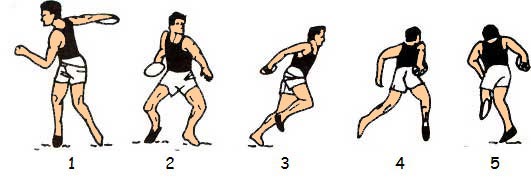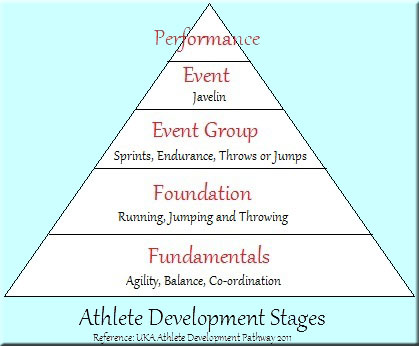

Discus
To achieve maximum distance in the discus, the athlete must balance three components - speed, technique and strength. The information on this page is for a right-handed thrower.
The hold
|
 |
Throwing Technique

- Figures 1 & 2
- Adopt a shoulder-width stance and perform preliminary swings
- Keep everything very long to provide the maximum possible radius on the discus
- Bodyweight in the middle of the stance
- Aim for chin over knee over the toe on the left leg
- Figures 3 & 4
- As the right foot leaves the ground, the weight must be over the left leg
- Discus kept high and relaxed, trailing behind the hips
- Swing the right foot wide of the left foot into the centre of the circle
- Figure 5
- On grounding, the right foot pivots on the ball of the foot
- Keep the left foot low and fast

- Figure 6
- Discus held high and back
- Keep the shoulders level and balanced
- As the right foot lands, aim for a chin over knee over the toe on the right leg
- Keep the left foot low and fast
- Figure 7
- The absolute power position is at the moment the left foot contacts the ground
- The left-arm points in the direction of the throw
- Right foot pivots
- The left side of the body is braced
- Drive the right hip forward
- Figure 8
- Right hip has been driven forward - note the "bow" position
- The right arm is extended and relaxed, ready to strike
- The left side kept firm and braced
- Figure 9
- The right arm comes through fast and last
- The release angle (angle between the horizontal and the right arm) for the discus has to take into consideration aerodynamic lift and drag.
- The left foot is kept grounded until well after the discus is released
- Check right thumb is pointing forward and in line with the arm
Optimum Distance
The distance achieved in the discus is dependent on three parameters:
- the height of release of the discus
- the angle of release of the discus
- the speed of release of the discus
The parameter that has the greatest effect on the potential distance is the speed of release of the discus.
Optimum Release Angle
Research (Bartonietz 1995)[2] has shown that athletes cannot throw at the same speed for all projection angles. With ballistics, the same initial speed is applied to the projectile regardless of the projection angle. As the angle increase, the speed decreases. This decrease in speed is a result of two factors:
- As the angle increases, the athlete must expend more energy in overcoming the weight of the discus, and so less effort is available to develop the release speed of the discus
- The structure of the body favours a throw in the horizontal direction
Each athlete has a unique release velocity and release angle combination that depends on their size, strength, and throwing technique. Each athlete has their own specific optimum release angle. Knicker (1997)[1] identifies that the optimum release angle for a world-class discus thrower may be 35°± 8°.
Specifications
The weight specification for the discus depends on gender and age.
| Gender\Age | 11-12 | 13-14 | 15-16 | 17-19 | 20-34 |
| Male | 1 kg | 1.25 kg | 1.5 kg | 1.75 kg | 2 kg |
| Female | 0.75 kg | 1 kg | 1 kg | 1 kg | 1 kg |
| Gender\Age | 35-49 | 50-59 | 60-69 | 70-79 | 80+ |
| Male | 2 kg | 1.5 kg | 1 kg | 1 kg | 1 kg |
| Gender\Age | 35-49 | 50-59 | 60-69 | 70-75 | 75+ |
| Female | 1 kg | 1 kg | 1 kg | 1 kg | 0.75 kg |
Training Programs
A training program has to be developed to meet the athlete's individual needs and consider many factors: gender, age, strengths, weaknesses, objectives, training facilities etc. As all athletes have different needs, a single program suitable for all athletes is not possible.
Training Pathway

Athletes in the Event Group stage
The following is an annual training program suitable for athletes in the Event Group Development stage:
Athletes in the Event stage
The following is an example of a specific annual training program suitable for athletes in the Event development stage:
Evaluation Tests
The following evaluation tests can be used to monitor the athlete's development:
- 60-metre speed test
- Quadrathlon
- Strength test - upper body (Bench Press)
- Strength test - lower body (Leg Press)
- Sit-Ups test - abdominal strength
- Sit and Reach test - lower back and hamstring test
- Vertical Jump test
Rules of Competition
The competition rules for this event are available from:
References
- KNICKER, A. (1997) Biomechanical analysis of the throwing events. In: BRUGGEMANN, D. et al. (1997) Biomechanical Research Project Athens 1997, final Report. Oxford, Meyer and Meyer Sport
- BARTONIETZ, K. and BARTONIETZ, A. (1995) The throwing events at the World Championships in Athletics 1995, Goteborg - Technique of the world's best athletes, Part 1: shot put and hammer throw. New Studies in Athletics, 10 (4), pp. 43-63
Page Reference
If you quote information from this page in your work, then the reference for this page is:
- MACKENZIE, B. (2002) Discus [WWW] Available from: https://www.brianmac.co.uk/dicus/index.htm [Accessed